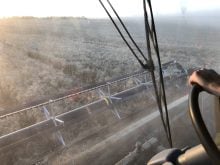The introduction of new herbicide-tolerant varieties has made weed control easier but it can still be a tricky situation
Sunflowers are one of the few crops that maintain a relatively stable acre count year after year. Very few sunflower growers drop out. Very few new growers enter the field.
This year might see a slight boost in sunflower acres as soybean and canola growers reduce acres. Soil suitable for soybeans is often high-quality land that’s been pampered over the years. The land is too expensive and has too much yield potential to put it into wheat. One alternative is to put those acres into sunflowers.
Read Also

U.S. bill could keep out Canadian truckers
The Protecting America’s Roads Act, which was tabled in the U.S. House of Representatives at the beginning of October, would “rid the country of illegal immigrant commercial truck drivers and ineligible foreign nationals.”
That’s the opinion of Rick Senecal, agronomist at Shur-Gro in Elie, Man. He says plantings of confectionary sunflower varieties will likely be down slightly, but there may be an increase in oilseed varieties to offset soybean and canola seed looking for new fields.
“Seed availability is a major factor for growers wanting to try sunflowers for the first time, or for veteran growers wanting to expand. There are not many seed suppliers. The bulk of the seed has already been spoken for, and some varieties are sold out. And last year was not the best for seed production, so volumes are down.
“Breaking up disease cycles is a benefit of putting sunflower into your rotation. It’s a normal part of the rotation for many of our regular customers, as part of what they view as good management.
“But you have to keep in mind that both canola and sunflowers are broadleaf and therefore susceptible to the same diseases. Sclerotinia, or white mould, is the same for canola and sunflower. Sunflowers are more challenging than canola, which is why you should only grow them once every four years. It’s more difficult to fight diseases in sunflower.”
Weed control had been more of a problem in years past, but that changed in the last five years with the introduction of more herbicide-selective varieties. For example, there are now Clearfield-tolerant sunflowers.
He says it’s tricky because there are only two products you can use. Sunflower is a broadleaf, so you can use herbicides that kill grassy weeds.
In conventional sunflowers, you can only go up to half rates to control broadleaf weeds such as buckwheat or lambs quarters.
“Once those sunflowers get going, they grow tall. They’ll do a really good job of shading out the weeds. The problem is getting them to that stage, because your plant count is so low. It’s only 18,000 to 22,000 plants per acre, so weeds have plenty of time and plenty of space to get ahead of the crop. That’s why it’s extremely important to keep those fields clean in the early stages.
“Without question you need a pre-emergent product like Authority or Authority Charge, which contain sulfentrazone and carfentrazone. That will control some of your toughest broadleaf weeds. The grasses are easier to control. All of those pre-emergent products are usually combined with Roundup for a pre-seed or post-seed burn-off before the sunflowers come through the ground.
“Authority leaves a residual for 21 to 30 days. Once the sunflowers are knee high, they pretty well take care of themselves, but you can still have a later weed flush that won’t affect yield.”
Senecal says that in the Red River Valley, growers always prepare a well-worked seedbed. That’s common in this part of the Prairies. He says further south and west at Waskada, Man., near the Saskatchewan border where zero-till is the norm, Shur-Gro sunflowers do well in a zero-till regime. He adds that zero-till practices hinder weed control because pre-emergent herbicides must have good soil contact to be effective.
Down the road at Carman, Man., Daryl Rex agrees that a black seedbed is necessary for a high-yielding sunflower crop. He is an agronomist with the National Sunflower Association of Canada.
“The black soil gives the seeds some heat, and will be especially important this year. But you also need excellent soil contact for the pre-emergent herbicides to perform at their best.”
That may be difficult if your well-thought-out rotation calls for a specific field and that field happens to be a sea of mud at the end of April. Or worse yet, it may still have the 2019 crop standing on that selected field. What if you cannot get caught up enough with your workload to plant flowers into a black seedbed?
“In that case, your first issue should be to find a hybrid sunflower, whether it’s herbicide-tolerant or a conventional hybrid. You should count on some weed problems into the growing season, so a herbicide-tolerant variety will give you options to deal with that. So, it’s not a lost cause. And guys know there’s enough good chemicals to deal with weeds in-season.
“In fact we’re seeing a few growers who’ve been away now coming back to sunflowers. I’m not certain, but I think it may have to do with the decline in soybean acres. If you don’t plant soybeans, you have to put something on that ground. It might as well be sunflowers.”


















